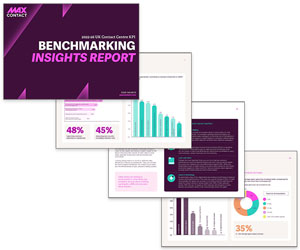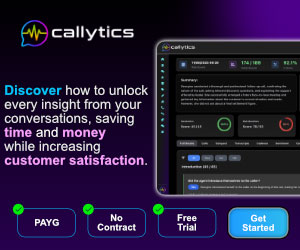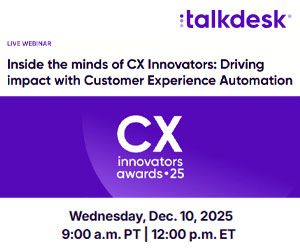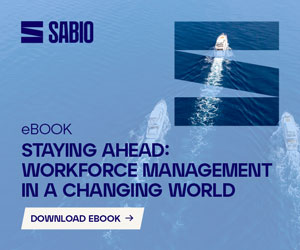VoC programmes are evolving fast! Moving beyond basic surveys to more dynamic, continuous listening strategies, tapping into real-time sentiment, emotion, and even intent to better understand and serve customers.
But as VoC matures, the big question becomes: What’s next?
To find out, we asked our panel of technology experts for their best thinking on the emerging tools, tactics, and cultural shifts that are truly changing the game for VoC.
“A CX Digital Twin Can Forecast the Impact of Business Decisions in Real Time”

Traditional VoC programmes relied on delayed feedback from a small fraction of customers, offering only a partial view of the experience. Now, CX teams can use AI-powered conversation analytics to analyse 100% of customer interactions, providing a complete, forward-looking perspective.
But the next frontier is strategic simulation!
A “CX Digital Twin” uses this data to forecast the impact of business decisions in real time. For example, an airline can model a $5 fee increase and instantly see the trade-off: $4M in additional revenue versus a 2.1-point NPS drop. Instead of a historical report card, VoC has become a critical guidance system for risk-aware, informed decision-making!
Contributed by: Taoufik Massoussi, Product Manager, Enghouse Interactive
“Leaders Can Ask Plain-English Questions Such as, “Who Are My Top Five Churn Risks, and What Should I Do About Them?”
The biggest challenge with VoC today isn’t collecting data – it’s doing something with it. The next phase is all about action.
Modern platforms automate key CX metrics like CSAT, NPS, and churn detection, surfacing high-risk customers in real time. Emerging AI co-pilots go even further: leaders can now ask plain-English questions such as, “Who are my top five churn risks, and what should I do about them?”
The system not only identifies the customers but also recommends targeted next steps. This bridges the gap between analytics and operations, turning VoC from a reporting exercise into a driver of retention, efficiency, and smarter coaching strategies.
Contributed by: Jonathan Kenu Escobedo, Customer Success Manager, MiaRec
You can also watch the video below where Jonathan explains what is next with VoC and how it can help spot friction before customers leave:
“Virtual Agents Can Be Deployed to Follow Up With Customers and Collect Feedback”
AI assistants can detect sentiment, summarize calls, and ensure quality control in real time.
These tools operate across voice, chat, and email, providing comprehensive omnichannel support.
Whilst virtual agents are now deployed to follow up with customers, collect feedback, and help validate and calibrate processes.
Advanced AI analytics uncover new insights, revealing trends and opportunities for improvement. As a result, VoC has evolved beyond simply gathering feedback; it’s now focused on delivering actionable insights that drive continuous enhancements to the customer experience.
Contributed by: Jurgen Hekkink, Head of Product Marketing, AnywhereNow
“Leaders Can Identify the Biggest Drivers of Dissatisfaction and Use Them to Make Targeted Improvements to Coaching”

Contact centres are increasingly turning to predictive AI models that analyse customer interactions and score them for satisfaction, sentiment, and effort in near real time.
Strategic contact centre leaders are using these predictive insights to inform both immediate and long-term improvements to the customer experience. Managers can review interactions with predicted dissatisfaction and determine if they should follow up directly with the customer, giving them the opportunity to turn a negative experience into a positive one.
Contact centre and CX leaders can use predictive analytics to identify the biggest drivers of dissatisfaction or effort, enabling them to make targeted improvements to coaching, real-time agent guidance, and upstream issues.
Contributed by: Simon Black, Chief Operating Officer, Creovai
For more insights on Voice of the Customer, take a look at our recorded webinar on Customer Feedback Tactics You Can’t Overlook.
“Agents Can See Contextual Guidance as Conversations Are Handed Off From Virtual Agents”

The future of Voice of the Customer (VoC) lies in applying the latest AI and LLM innovations to move from insight to real-time action and feedback loops.
The game is changing with:
- AI transcripts that provide agents with contextual guidance as conversations are handed off from virtual agents.
- Real-time sentiment analysis that goes beyond keywords to understand emotion and tone.
- AI Agent Assist that provides live coaching and next-best-action guidance based on that intelligence.
- Conversational AI that analyses the “why” behind every interaction, scoring CSAT without surveys, and helping ground you in conversational truth.
- Automated quality management that scores 100% of all virtual and human-led interactions.
By embracing these innovations, organizations can create a closed-loop VoC strategy that ensures every interaction is a brilliant one.
Contributed by: Matthew Clare, VP, Product Marketing, UJET
You can also watch the video below where Matthew explains what is next with VoC and how it is developing to become what we’ve always wanted it to be:
“Cross-Functional Alignment, Agent Empowerment, and Closed-Loop Feedback Will Be Critical”

The future of Voice of the Customer is less about collecting feedback and more about connecting it. But technology alone isn’t enough.
The real shift is cultural – embedding VoC into the heart of the organization, not just as a metric but as a mindset. Cross-functional alignment, agent empowerment, and closed-loop feedback are critical.
The next evolution of VoC is actionable, always-on, and owned by everyone – from the agent to the C-suite. Success lies in turning insights into outcomes: smarter journeys, faster resolutions, and experiences that customers feel were designed for them.
Contributed by: Tara Aldridge, Strategic Services Director, Vonage
“The Real Differentiator Will Be When You Understand What Customers Have Purchased, Where the Pain Points Are, and How Each Customer Behaves”

The real power of modern VoC is in connecting insights with context. It’s not enough to know how customers feel.
The real differentiator is when you understand what customers have purchased, where the pain points are, and how each customer behaves. With that level of visibility, contact centres finally move from reactive to proactive support.
When VoC is embedded into the support organization, you can identify customers who just bought a product with a known issue and reach out before frustration builds, or tailor guidance based on a customer’s past interactions and preferences.
When organizations combine purchase history, product flaws, and behavioural patterns with real-time sentiment, they can anticipate needs, prevent problems, and personalize experiences at scale.
Contributed by: Florian Garnier, Product Marketing Manager, Calabrio
“Contact Centres Will Stop Chasing Vanity Metrics That Don’t Move the CX Needle”

VoC should cover all channels, to capture a true picture of CX.
AI and machine learning tools now enable businesses to analyse conversations at scale. By linking CCaaS interactions with business data, it’s possible to track behaviour and compare what customers say with what they actually do. This allows for richer experiences… And faster intervention if things go wrong.
Organizations also sometimes rely on rigid surveys, chasing ‘vanity’ metrics that don’t move the CX needle and missing the value VoC programmes bring. Well-crafted, customer-centric questions and feedback are what unlock honest and useful insights.
Finally, the biggest leap for me will be around Agentic AI to drive analysis, personalization and impact needed for all customers.
Contributed by: Lewis Gallagher, Senior Solutions Consultant, Netcall
“You’ll Be Able to Spot Friction BEFORE Customers Even Consider Leaving”

For years, Voice of the Customer (VoC) relied on post-call CSAT and NPS surveys – but they capture only a fraction of customer sentiment. What’s next is a shift toward analysing 100% of customer interactions, not just a sample.
AI-powered VoC platforms now process conversations in real time, identifying sentiment, topics, and even intent. This creates a complete picture of the customer experience while eliminating survey fatigue.
The real breakthrough lies in proactive detection – spotting friction before it escalates, flagging churn risks earlier, and improving experiences before customers even consider leaving.
Contributed by: Jonathan Kenu Escobedo, Customer Success Manager, MiaRec
“You’ll Be Able to Close the Feedback Loop More Quickly, While Ensuring Every Customer Feels Heard”
Beyond workflows, AI can propose pre-written responses to survey or review feedback, enabling teams to close the loop quickly while ensuring every customer feels heard.
Over time, AI will also identify patterns and trends across interactions, recommending strategic actions like updating FAQs, improving IVR menus, or training agents on recurring issues, helping organizations act proactively rather than reactively.
Contributed by: Taoufik Massoussi, Product Manager, Enghouse Interactive
“Cultural Shifts Will Dissolve Traditional Silos and Encourage Shared Responsibility for Customer Satisfaction”

Customer experience stands as a key differentiator in a marketplace where products and online services are increasingly commoditized.
Our philosophy that “anyone can be an agent” exemplifies a growing movement to empower every employee to be part of the customer experience.
This cultural shift helps dissolve traditional silos and encourages shared responsibility for customer satisfaction.
By embedding VoC into everyday workflows, companies are developing more responsive, empathetic, and customer-centric cultures that help them stand out in a competitive environment.
Contributed by: Jurgen Hekkink, Head of Product Marketing, AnywhereNow
“VoC Programmes Will Extend to the ‘Internal Customer’ and Monitoring Agent Wellbeing Too”

Voice of the Customer programmes are evolving from low-response post-call surveys into continuous, AI-powered listening tools that capture sentiment, emotion, and intent across every interaction and channel.
By extracting insights directly from conversations, rather than asking customers to fill in forms, organizations can capture a more representative view of experience, beyond just the most motivated respondents.
The future of VoC also extends inward to the ‘internal customer’. Monitoring agent wellbeing and likely stressful calls over the course of a shift can help optimize an agent’s workload to prevent burnout. If an agent receives a few tough calls in a row, they could be offered some slower work.
Contributed by: Martin Taylor, Co-Founder and Deputy CEO, Content Guru
For more great insights and advice from our panel of experts, read these articles next:
- Where Do WFM Systems Have the Biggest Impact?
- 10 New Ways Tech Is Helping Agents Right Now
- Bad Habits That Kill Resource Planning
Author: Megan Jones
Reviewed by: Jo Robinson
Published On: 16th Sep 2025 - Last modified: 19th Sep 2025
Read more about - Technology, AnywhereNow, Artificial Intelligence (AI), Calabrio, Content Guru, Conversational AI, Creovai, Customer Experience (CX), Customer Feedback, Enghouse Interactive, Florian Garnier, Jonathan Kenu Escobedo, Jurgen Hekkink, Lewis Gallagher, Martin Taylor, Matthew Clare, MiaRec, Netcall, Simon Black, Taoufik Massoussi, Tara Aldridge, Top Story, UJET, Voice of the Customer, Vonage











































